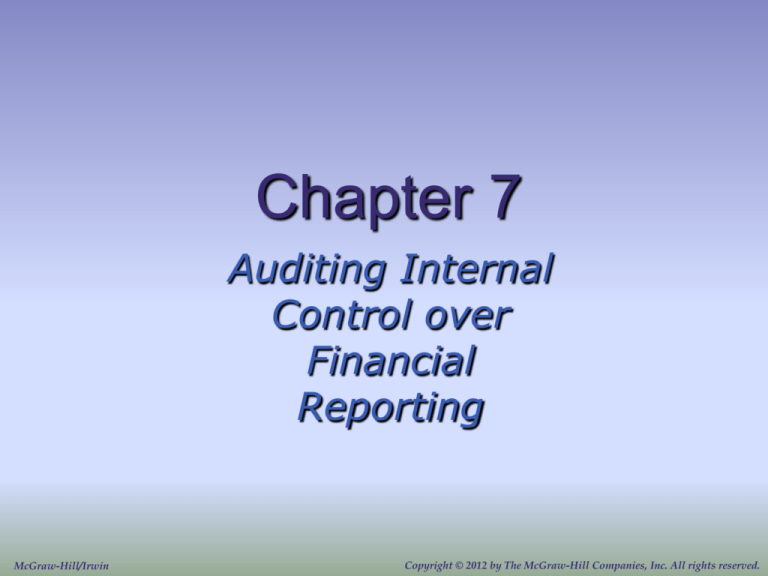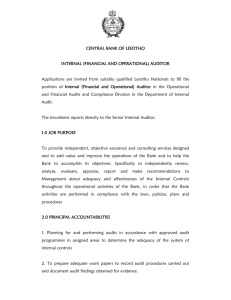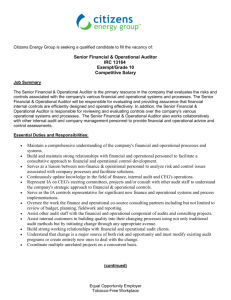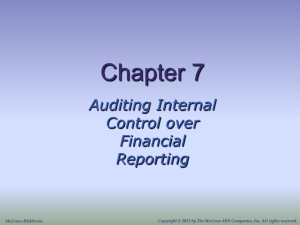
Chapter 7
Auditing Internal
Control over
Financial
Reporting
McGraw-Hill/Irwin
Copyright © 2012 by The McGraw-Hill Companies, Inc. All rights reserved.
LO# 1
Management Responsibilities
under Section 404
Section 404 of the Sarbanes-Oxley Act requires
managements of publicly traded companies to issue
an internal control report that explicitly accepts
responsibility for establishing and maintaining
“adequate” internal control over financial reporting
(ICFR).
7-2
LO# 1
Management Responsibilities
under Section 404
Management must comply with the following
requirements in order for the external auditor to
complete an audit of ICFR.
1. Accept responsibility for the effectiveness of the
entity’s ICFR.
2. Evaluate the effectiveness of the entity’s ICFR
using suitable control criteria.
3. Support the evaluation with sufficient evidence,
including documentation.
4. Present a written assessment regarding the
effectiveness of the entity’s ICFR as of the end of
the entity’s most recent fiscal year.
7-3
LO# 2
Auditor Responsibilities under
Section 404 and AS5
The entity’s independent auditor must audit and report
on the effectiveness of ICFR. The auditor is required to
conduct an integrated audit of the entity’s ICFR and
its financial statements.
7-4
LO# 3
ICFR Defined
ICFR is defined as a process designed to provide reasonable
assurance regarding the reliability of financial reporting and
the preparation of financial statements in accordance with
GAAP. Controls include procedures that:
1. Pertain to the maintenance of records that fairly reflect the
transactions and dispositions of the assets of the company.
2. Provide reasonable assurance that transactions are
recorded in accordance with GAAP.
3. Provide reasonable assurance regarding prevention or
timely detection of unauthorized acquisition, use, or
disposition of the company’s assets.
7-5
LO# 4
Internal Control Deficiencies
Defined
A control deficiency exists when the design or operation
of a control does not allow management or employees, in
the normal course of performing their assigned functions,
to prevent or detect misstatements on a timely basis.
A significant deficiency is a deficiency, or a combination
of deficiencies, in internal control over financial reporting
that is less severe than a material weakness, yet
important enough to merit attention by those responsible
for oversight of the company's financial reporting.
7-6
LO# 4
Internal Control Deficiencies
Defined
A control deficiency may be serious enough that it is to
be considered not only a significant deficiency but also a
material weakness in the system of internal control. A
material weakness is a deficiency, or a combination of
deficiencies, in ICFR, such that there is a reasonable
possibility that a material misstatement of the annual or
interim financial statements will not be prevented or
detected on a timely basis.
As illustrated on the next slide, the auditor must consider
two dimensions of the control deficiency:
likelihood (reasonably possible), and
magnitude (material, consequential, or inconsequential)
7-7
Internal Control Deficiencies
Defined
M
A
G
N
I
T
U
D
E
LO# 4
Material
weakness
Material
Significant
deficiency
Not material
but significant
Control
deficiency
Not material
or significant
Remote
Reasonably possible or probable
LIKELIHOOD
7-8
LO# 5
Management’s Assessment
Process
Management must follow a top-down, risk-based
approach:
1. Identify financial reporting risks and controls.
2. Evaluate evidence about the operating effectiveness of
ICFR.
3. Consider which locations to include in the evaluation.
7-9
LO# 5
Framework Used by Management
to Conduct Its Assessment
Most entities use the framework developed by COSO.
This framework identifies three primary objectives of
internal control: (1) reliable financial reporting;
(2) efficiency and effectiveness of operations;
and (3) compliance with laws and regulations.
7-10
LO# 5
Management’s Documentation
Management must develop sufficient
documentation to support its assessment of the
effectiveness of internal control. This
documentation may take many forms, such as
paper, electronic files, or other media. It also
includes policy manuals, process models,
flowcharts, job descriptions, documents, and
forms.
7-11
LO# 6
Integrating the Audits of Internal
Control and Financial Statements
An integrated audit is composed of the audits of internal
control and the financial statements. The control testing
impacts the planned substantive procedures. Also, the
results of the substantive procedures are considered in
the evaluation of internal control.
Tests of
internal
control
Substantive
audit
procedures
7-12
LO# 6
Performing an Audit of ICFR
Figure 7-2
7-13
LO# 7
Planning the Audit of ICFR
The
planning process is similar to the
process used for the audit of financial
statements.
Consider the following:
– Risk assessment and the risk of fraud.
– Scaling the audit.
– Using the work of others.
7-14
LO# 7
Special Consideration:
Using the Work of Others
A major consideration for the external auditor is how much
work is to be performed by others. In determining the extent to
which the auditor may use the work of others, the auditor
should:
(1) evaluate the nature of the controls subjected to the work of
others,
(2) evaluate the competence and objectivity of the individuals
who performed the work, and
(3) test some of the work performed by others to evaluate the
quality and effectiveness of their work.
As the risk associated with the control being tested increases,
the external auditor should do more of the work.
7-15
LO# 8
Using a Top-Down Approach
Figure 7-3
7-16
LO# 5
Identify Entity-Level Controls
7-17
LO# 8
Identifying Significant Accounts
Size and composition of the account
Susceptibility to misstatement due to
errors or fraud
Volume of activity, complexity, and
homogeneity of the individual transactions
processed through the account or
reflected in the disclosure
Nature of the account or disclosure
Accounting and reporting complexities
associated with the account or disclosure
7-18
LO# 8
Identifying Significant Accounts
Exposure
to losses in the account
Possibility of significant contingent
liabilities arising from the activities
reflected in the account or disclosure
Existence of related-party
transactions in the account
Changes from the prior period in
account or disclosure characteristics
7-19
LO# 8
Sources of Misstatements
Understand the flow of transactions related to the
relevant assertions
Identify the points within the entity’s processes at
which a misstatement could arise that would be
material
Identify the controls that management has
implemented to address these potential
misstatements
Identify the controls that management has
implemented over the prevention or timely detection
of unauthorized acquisition, use, or disposition of the
company’s assets that could result in a material
misstatement of the financial statements
7-20
LO# 8
Select Controls to Test
7-21
LO# 9
Test the Design and Operating
Effectiveness of Controls
Evaluate
design
Test and evaluate operating
effectiveness
– Nature: Inquiry, Inspection of documents,
observation, and reperformance.
– Timing: Interim vs. “as of” date
– Extent: Consider (1) Nature of the control;
(2) Frequency of operation; and
(3) Importance of the control.
7-22
Internal Control Deficiencies
Defined
M
A
G
N
I
T
U
D
E
LO# 4
Material
weakness
Material
Significant
deficiency
Not material
but significant
Control
deficiency
Not material
or significant
Remote
Reasonably possible or probable
LIKELIHOOD
7-23
LO# 10
Evaluate Identified Control Deficiencies
As discussed previously, the auditor must consider the
likelihood and magnitude of the control deficiency.
7-24
LO# 10
Evaluate Identified Control Deficiencies
If a deficiency, or combination of deficiencies,
prevents the auditor from having reasonable
assurance that transactions are recorded properly,
then the auditor should treat the deficiency as an
indicator of a material weakness.
7-25
LO# 11
Remediation of a Material
Weakness
Remediation
is the process of
correcting a material weakness in the
ICFR
– If a material weakness is corrected
before the “as of” date, there must be
sufficient time for both management
and the auditor to test the operating
effectiveness of the control – if not, an
adverse opinion (or disclaimer) is still
issued.
7-26
LO# 12
Written Representations
In addition to the management representations obtained
as part of a financial statement audit, the auditor also
obtains written representations from management related
to the audit of ICFR.
Failure to obtain written
representations from
management, including
management’s refusal to
furnish them, constitutes a
limitation on the scope of the
audit sufficient to preclude an
unqualified opinion.
7-27
Auditor Documentation
Requirements
LO# 13
The auditor must properly document the processes,
procedures, judgments, and results relating to the audit
of internal control.
When an entity has effective
ICFR, the auditor should be
able to perform sufficient
testing of controls to assess
control risk for all relevant
assertions at a low level.
7-28
LO# 13
Auditor Documentation Requirements
The auditor’s documentation of the process, procedures,
judgments and results relating to the audit of ICFR should
include:
1. The auditor’s understanding and evaluation of the
design of each of the components of ICFR;
2. The process used to determine the points at which
misstatements could occur;
3. The extent to which the auditor relied upon the work of
others; and
4. The evaluation of any deficiencies discovered or other
findings which could result in a report modification.
7-29
LO# 14
Types of Reports Relating to the
Audit of ICFR
An unqualified opinion signifies that the client’s
internal control is designed and operating
effectively (no material weaknesses).
A serious scope limitation requires the auditor to
disclaim an opinion.
An adverse opinion is required if a material
weakness is identified.
7-30
LO# 14
Types of Reports Relating to the
Audit of ICFR
Report Modification Based on Control Deficiencies
Likelihood/Magnitude
of Misstatement
Control
deficiency
Significant
deficiency
Material
weakness
Type of
Audit Report
Unqualified
opinion
Adverse
opinion
7-31
LO# 14
Types of Reports Relating to the
Audit of Internal Control
Report Modification Based on Scope Limitation
Seriousness of
Scope Limitation
Minor
effect
Severe
limitation
Type of
Audit Report
Unqualified
opinion
Disclaim
opinion or
withdraw
7-32
LO# 14
Internal Control Audit Report
•
Similar to F/S Audit Report except after scope
paragraph there is a Definition paragraph and
then an Inherent Limitations Paragraph
•
Internal Control Audit Report can be presented
in one of two ways:
1. Separate Report (p. 247)
2. Combined Report (p. 248-249)
7-33
LO# 14
Other Reporting Issues
1. Management’s report is incomplete or improperly
presented.
2. The auditor decides to refer to the report of other
auditors.
3. A significant subsequent event has occurred.
4. There is additional information contained in
management’s report on internal control.
5. There is a remediated material weakness at an interim
date.
7-34
LO# 15
Additional Required Communications
in an Audit of ICFR
The auditor must communicate in writing to management
and the audit committee all significant deficiencies and
material weaknesses identified during the audit (AS5).
This communication should be made prior to the issuance
of the auditor’s report on ICFR. In addition, the auditor
should communicate to management, in writing, all
control deficiencies identified during the audit and inform
the audit committee when such a communication has
been made.
7-35
LO# 17
Advanced Module 1: Safeguarding
of Assets
Safeguarding of assets is defined as policies
and procedures that “provide reasonable
assurance regarding prevention or timely
detection of unauthorized acquisition, use, or
disposition of the company’s assets that could
have a material effect on the financial
statements.”
7-36
LO# 18
Advanced Module 2:
Computer-Assisted Audit Techniques
Computer-assisted audit techniques (CAATs)
include:
• Generalized audit software packages.
• Custom audit software.
• Test data.
7-37
Advanced Module 2: Generalized
Audit Software
LO# 18
7-38
LO# 18
Advanced Module 2: Custom Audit
Software
Custom audit software is generally written by auditors
for specific audit tasks. It may be required when the
client’s computer system is not compatible with the
auditor’s generalized audit software.
Custom software:
(1) Is expensive to develop.
(2) Requires long development time.
(3) May require extensive modification if
the client changes its accounting
application programs.
7-39
LO# 18
Advanced Module 2: Test Data
Test data are developed by the auditor to test the
application controls in the client’s computer programs.
The technique can be used to check (1) data validation
controls and error detection routines, (2) processing
logic controls, (3) arithmetic calculations, and (4) the
inclusion of transactions in records, files, and reports.
7-40









